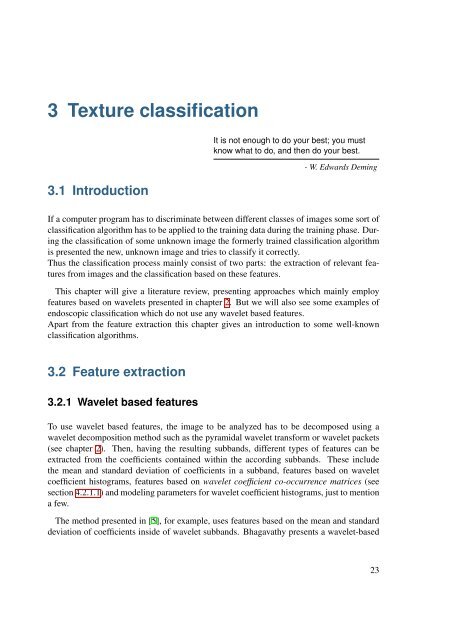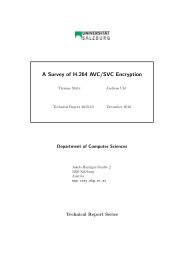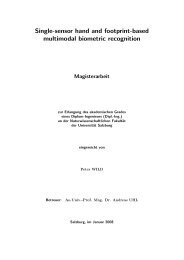Pit Pattern Classification in Colonoscopy using Wavelets - WaveLab
Pit Pattern Classification in Colonoscopy using Wavelets - WaveLab
Pit Pattern Classification in Colonoscopy using Wavelets - WaveLab
Create successful ePaper yourself
Turn your PDF publications into a flip-book with our unique Google optimized e-Paper software.
3 Texture classification<br />
3.1 Introduction<br />
It is not enough to do your best; you must<br />
know what to do, and then do your best.<br />
- W. Edwards Dem<strong>in</strong>g<br />
If a computer program has to discrim<strong>in</strong>ate between different classes of images some sort of<br />
classification algorithm has to be applied to the tra<strong>in</strong><strong>in</strong>g data dur<strong>in</strong>g the tra<strong>in</strong><strong>in</strong>g phase. Dur<strong>in</strong>g<br />
the classification of some unknown image the formerly tra<strong>in</strong>ed classification algorithm<br />
is presented the new, unknown image and tries to classify it correctly.<br />
Thus the classification process ma<strong>in</strong>ly consist of two parts: the extraction of relevant features<br />
from images and the classification based on these features.<br />
This chapter will give a literature review, present<strong>in</strong>g approaches which ma<strong>in</strong>ly employ<br />
features based on wavelets presented <strong>in</strong> chapter 2. But we will also see some examples of<br />
endoscopic classification which do not use any wavelet based features.<br />
Apart from the feature extraction this chapter gives an <strong>in</strong>troduction to some well-known<br />
classification algorithms.<br />
3.2 Feature extraction<br />
3.2.1 Wavelet based features<br />
To use wavelet based features, the image to be analyzed has to be decomposed us<strong>in</strong>g a<br />
wavelet decomposition method such as the pyramidal wavelet transform or wavelet packets<br />
(see chapter 2). Then, hav<strong>in</strong>g the result<strong>in</strong>g subbands, different types of features can be<br />
extracted from the coefficients conta<strong>in</strong>ed with<strong>in</strong> the accord<strong>in</strong>g subbands. These <strong>in</strong>clude<br />
the mean and standard deviation of coefficients <strong>in</strong> a subband, features based on wavelet<br />
coefficient histograms, features based on wavelet coefficient co-occurrence matrices (see<br />
section 4.2.1.1) and model<strong>in</strong>g parameters for wavelet coefficient histograms, just to mention<br />
a few.<br />
The method presented <strong>in</strong> [5], for example, uses features based on the mean and standard<br />
deviation of coefficients <strong>in</strong>side of wavelet subbands. Bhagavathy presents a wavelet-based<br />
23








